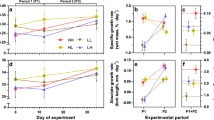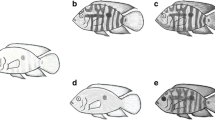Abstract
Salmonids form dominance hierarchies in environments, where space or food are limiting. Our first objective was to investigate the physiology of individual rainbow trout in 4-fish hierarchies. Our second was to compare conclusions drawn from grouping physiological data on the basis of social rank with those based on relating individual physiology to individual aggressive behavior. To create a social hierarchy, groups of 4 juvenile trout were fed (1 % ration) using a darkened feeding container, twice daily (morning and evening). Each morning feeding was videotaped to record aggressive behavior, thereby facilitating the assignment of a social status rank to each fish. On days 5 and 10–11, physiological parameters were measured in fish fasted for 24 h. Social hierarchies formed in all tested groups. One fish would become dominant, whereas the three subordinate individuals would each assume a stable social rank. When classified according to this social rank, the three subordinate individuals all displayed similar physiology, different from the physiology of the dominant fish. The latter included higher ammonia excretion rate, greater protein utilization in aerobic metabolism, greater feeding, higher specific growth rate, greater increase in condition factor, and lower routine oxygen consumption rate. However, when individual aggression was taken into account, a continuous gradient was observed between aggression and physiology for most parameters, regardless of social status. These relationships could be improved by normalizing the aggression score to the overall level of aggression in each hierarchy. We argue that individual behavior should be considered instead of just social rank when studying the physiology of trout in social hierarchies.









Similar content being viewed by others
References
Abbot JC, Dill LM (1989) The relative growth of dominant and subordinate juvenile steelhead trout (Salmo gairdneri) fed equal rations. Behaviour 108:104–113
Alsop DH, Wood CM (1997) The interactive effects of feeding and exercise on oxygen consumption, swimming performance and protein usage in juvenile rainbow trout (Oncorhynchus mykiss). J Exp Biol 200:2337–2346
Alves LC, Glover CN, Wood CM (2006) Dietary Pb accumulation in juvenile freshwater rainbow trout (Oncorhynchus mykiss). Arch Environ Contam Toxicol 51:615–625
Boutilier RG, Hemming TA, Iwama GK (1984) Physiochemical parameters for use in fish respiratory physiology. In: Hoar WS, Randal DJ (eds) Fish physiology. Vol. 10. Pt. A. Anatomy gas transfer and acid base regulation, vol 10. Academic Press, New York, pp 403–430
Brett JR, Zala CA (1975) Daily pattern of nitrogen excretion and oxygen consumption of sockeye salmon (Oncorhynchus nerka) under controlled conditions. J Fish Res Board Can 32:2479–2486
Briffa M, Elwood RW (2010) Repeated measures analysis of contests and other dyadic interactions: problem of semantics, not statistical validity. Anim Behav 80:583–588
Brown GE, Brown JA (1993) Social dynamics in salmonid fishes: do kin make better neighbours. Anim Behav 45:863–871
Bucking C, Wood CM (2008) The alkaline tide and ammonia excretion after voluntary feeding in freshwater rainbow trout. J Exp Biol 211:2533–2541
Chapman DW (1966) Food and space as regulators of salmonid populations in streams. Am Nat 100:345–357
Copeland DL, Levay B, Sivaraman B, Beebe-Fugloni C, Earley RL (2011) Metabolic costs of fighting are driven by contest performance in male convict cichlid fish. Anim Behav 82:271–280
De Boeck G, Alsop DH, Wood CM (2001) Cortisol effects on aerobic and anaerobic metabolism, nitrogen excretion, and whole-body composition in juvenile rainbow trout. Physiol Biochem Zool 74:858–868
Earley RL, Blumer LS, Grober MS (2003) The gall of subordination: changes in gall bladder function associated with social stress. Proc R Soc Land B 271:7–13
Filby AL, Paul GC, Bartlett EJ, Van Look KJW, Tyler CR (2010) Physiological and health consequences of social status in zebrafish (Danio rerio). Physiol Behav 101:576–587
Fox HE, White SA, Koa MHF, Fernald RD (1997) Stress and dominance in a social fish. J Neurosci 17:6463–6469
Gilmour KM, DiBattista JD, Thomas JB (2005) Physiological causes and consequences of social status in salmonid fish. Integr Comput Biol 45:263–273
Gregory TR, Wood CM (1999a) Interactions between individual feeding behaviour, growth and swimming performance in juvenile rainbow trout (Oncorhynchus mykiss) fed different rations. Can J Fish Aquat Sci 56:479–486
Gregory TR, Wood CM (1999b) The effects of chronic plasma cortisol elevation on the feeding behaviour, growth, competitive ability, and swimming performance of juvenile rainbow trout. Physiol Biochem Zool 72:286–295
Gurney WAC, Nisbet RM (1979) Ecological stability and social hierarchy. Theor Pop Biol 16:48–80
Harwood AJ, Armstrong JD, Metcalfe NB, Griffiths SW (2003) Does dominance status correlate with growth in wild stream-dwelling Atlantic salmon (Salmo salar). Behav Ecol 14:902–908
Hoglund E, Balm PHM, Winberg S (2002) Behavioural and neuroendocrine effects of environmental background colour and social interaction in Artic charr (Salvelinus alpines). J Exp Biol 205:2535–2543
Lauff RF, Wood CM (1996) Respiratory gas exchange, nitrogenous waste excretion and fuel usage during starvation in juvenile rainbow trout, Oncorhynchus mykiss. J Comp Physiol B 165:542–551
McCarthy ID (2001) Competitive ability is related to metabolic asymmetry in juvenile rainbow trout. J Fish Biol 59:1002–1014
McCarthy ID, Carter CG, Houlihan DF (1992) The effect of feeding hierarchy on individual variability in daily feeding of rainbow trout, Oncorhynchus mykiss (Walbaum). J Fish Biol 41:3–257
Metcalfe NB, Taylor AC, Thorpe JE (1995) Metabolic rate, social status and life-history strategies in Atlantic salmon. Anim Behav 49:431–436
Mommsen TP, Hochachka PW (1988) The purine nucleotide cycle as two temporally separated metabolic units: a study on trout muscle. Metabolism 37:552–556
Morgan JD, Iwama GK (1996) Cortisol-induced changes in oxygen consumption and ionic regulation in coastal cutthroat trout (Oncorhynchus clarki clarki) parr. Fish Physiol Biochem 15:385–394
Nicieza AG, Metcalfe NB (1999) Costs of rapid growth: the risk of aggression is higher for fast-growing salmon. Funct Ecol 13:793–800
Øverli O, Harris CA, Winberg S (1999) Short-term effects of fights for social dominance and the establishment of dominant-subordinate relationships on brain monoamines and cortisol in rainbow trout. Brain Behav Evol 54:263–275
Øverli O, Korzan WJ, Hoglund E, Winberg S, Bollig H, Watt M, Forster GL, Barton BA, Øverli E, Renner KJ, Summers CH (2004) Stress coping style predicts aggression and social dominance in rainbow trout. Horm Behav 45:235–241
Peters G, Faisal M, Lang T, Ahmed I (1988) Stress caused by social interaction and its effect on susceptibility to Aeromonas hydrophila infection in rainbow trout Salmo gairdneri. Dis Aquat Org 2:83–89
Pottinger TG, Pickering AD (1992) The influence of social interaction on the acclimation of rainbow trout, Oncorhynchus mykiss (Walbaum) to chronic stress. J Fish Biol 41:435–447
Secor S (2009) Specific dynamic action: a review of the postprandial metabolic response. J Comp Physiol B 179:1–56
Sloman KA, Armstrong JD (2002) Physiological effects of dominance hierarchies: laboratory artefacts or natural phenomena? J Fish Biol 61:1–23
Sloman KA, Taylor AC, Metcalfe NB, Gilmour KM (2000a) Effects of an environmental perturbation on the social behaviour and physiological function of brown trout. Anim Behav 61:325–333
Sloman KA, Gilmour KM, Taylor AC, Metcalfe NB (2000b) Physiological effects of dominance hierarchies within groups of brown trout, Salmo trutta, held under stimulated natural conditions. Fish Physiol Biochem 22:11–20
Sloman KA, Motherwell G, O’Connor KI, Taylor AC (2000c) The effect of social stress on the standard metabolic rate (SMR) of brown trout, Salmon trutta. Fish Physiol Biochem 23:49–53
Sloman KA, Metcalfe NB, Taylor AC, Gilmour KM (2001) Plasma cortisol concentrations before and after social stress in rainbow trout and brown trout. Physiol Biochem Zool 74:383–389
Sloman KA, Baker D, Winberg S, Wilson RW (2008) Are there physiological correlates of dominance in natural trout populations. Anim Behav 76:1279–1287
van den Thillart G (1986) Energy metabolism of swimming trout (Salmo gairdneri). J Comp Physiol 156:511–520
van Leeuwen TE, Rosenfeld JS, Richards JG (2012) Effects of food ration on SMR: influence of food consumption on individual variation in metabolic rate in juvenile coho salmon (Onchorhynchus kisutch). J Anim Ecol 2:395–402
Verdouw H, van Echteld CJA, Dekkers EMJ (1978) Ammonia determination based on indophenols formation with sodium salicylate. Water Res 12:399–402
Acknowledgments
Supported by an NSERC (Canada) Discovery grant to CMW. We thank Drs. S. Balshine, K. Sloman, and J. Quinn, as well as three anonymous referees for excellent advice. Also, we thank Sunita Nadella for her statistical expertise and Linda Diao for her technical support.
Author information
Authors and Affiliations
Corresponding author
Additional information
Communicated by G. Heldmaier.
Rights and permissions
About this article
Cite this article
Grobler, J.M.B., Wood, C.M. The physiology of rainbow trout in social hierarchies: two ways of looking at the same data. J Comp Physiol B 183, 787–799 (2013). https://doi.org/10.1007/s00360-013-0752-5
Received:
Revised:
Accepted:
Published:
Issue Date:
DOI: https://doi.org/10.1007/s00360-013-0752-5




